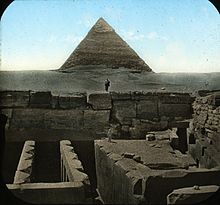Minkhaf I was an ancient Egyptian prince of the 4th Dynasty. He was a son of Pharaoh Khufu, half-brother of Pharaoh Djedefre and elder brother of Pharaoh Khafre.[2] His mother may have been Queen Henutsen.[3] Minkhaf had a wife and at least one son, but their names are not known.[4] Minkhaf served as vizier possibly under Khufu or Khafre.
| Minkhaf I in hieroglyphs | ||||
|---|---|---|---|---|
Minkhaf Mn.w ḫˁ=f He appears, the god Min | ||||
| Minkhaf I | |
|---|---|
| Vizier | |
 | |
| Dynasty | 4th Dynasty |
| Pharaoh | Khufu |
| Father | Khufu |
| Mother | possibly Henutsen |
| Wife | unknown woman |
| Children | Son |
Tomb
editMinkhaf was buried in the double mastaba numbered G 7430-7440 in the East Field, which is part of the Giza Necropolis. The construction of the mastaba started during the reign of his father Khufu.[5] The mastaba contained an interior chapel and an exterior chapel consisting of four rooms. One of the rooms was built to house at least four statues. The niches were large enough to hold standing statues and the niches were inscribed with Minkhaf's name and titles.[6]
Two burial shafts were found, labeled G 7430 A and G 7430 B. Shaft G 7430 A contained Minkhaf's sarcophagus which was found in a coffin pit located on the western side of the burial chamber. A canopic pit where the Canopic jars would have been stored was located in the south-east corner of the burial chamber. Shaft G 7430 B belonged to Minkhaf's wife, but the structure was unfinished and appears to not have been used.[6] Minkhaf's sarcophagus is now in the Egyptian Museum in Cairo.[2]
Titles
editDjedefhor's titles were:[7]
| Title | Translation | Jones Index |
|---|---|---|
| imy-rȝ kȝt nbt (nt) nzwt | overseer of all works of the king | 950 |
| tȝyty zȝb ṯȝty | he of the curtain, chief justice, vizier | 3706 |
| iry-pˁt | hereditary prince/nobleman, 'keeper of the patricians' | 1157 |
| wr di.w pr ḏḥwty | Greatest of the Five in the temple of Thoth | 1471 |
| mniw nḫn | protector/guardian of Hierakonpolis | 1597 |
| rȝ p nb | mouth of every Pe-ite/Butite (see Buto) | 1831 |
| ḥȝty-ˁ | count | 1858 |
| ḥry-sštȝ n it.f | privy to the secret of his father | 2241 |
| ḥry-sštȝ n nzwt m swt.f nbt | privy to the secret [of the king in] all his cult places/secretary [of the king in] all his cult-places | 2311 |
| ḫrp ˁḥ | director of the ˁḥ palace | 2579 |
| ẖry-ḥbt | lector priest, 'he who cames the ritual-book' | 2848 |
| ẖry-ḥbt ḥry-tp | chief lector priest, lector priest in charge | 2860 |
| zȝ nswt | king's son | 2911 |
| zȝ nswt n ẖt.f smsw | king's eldest son of his body | 2914 |
| zš mḏȝt-nṯr | scribe of the god's book | 3132 |
| smr | companion, courtier | 3263 |
| smr wˁty | sole companion | 3268 |
| smr wˁty n it.f | sole companion of his father | 3272 |
| nb imȝḫw ḫr it.f | possessor of reverence with his father | 1782 |
Translation and indexes from Dilwyn Jones.[8]
Sources
edit- ^ Hermann Ranke: Die ägyptische Persönennamen. Verlag von J. J. Augustin in Glückstadt, 1935., p. 265
- ^ a b Dodson, Aidan; Hilton, Dyan (2004). The Complete Royal Families of Ancient Egypt. London: Thames & Hudson. ISBN 0-500-05128-3., p. 60
- ^ Porter, Bertha and Moss, Rosalind, Topographical Bibliography of Ancient Egyptian Hieroglyphic Texts, Statues, Reliefs, and Paintings Volume III: Memphis, Part I Abu Rawash to Abusir. 2nd edition; revised and augmented by Dr Jaromir Malek, 1974. Retrieved from gizapyramids.org
- ^ Nefertkau, the eldest daughter of Sneferu
- ^ George A. Reisner, A History of the Giza Necropolis I, Cambridge: Harvard University Press, 1942, pp. 70–74, Retrieved from Giza Digital Library: History of the Giza Necropolis Series Archived 2011-07-26 at the Wayback Machine
- ^ a b George A. Reisner and William Stevenson Smith, A History of the Giza Necropolis II, Appendix B: Cemetery 7000 by George Reisner, Harvard University Press, 1955, pp. 45-50 Appendix B: Cemetery 7000 by George Reisner
- ^ Baud, Michel, Famille royale et pouvoir sous l'Ancien Empire Egyptien 1 & 2 IFAO, 1999, ISBN 2-7247-0248-4.
- ^ Jones, Dilwyn, An Index Of Ancient Egyptian Titles Epithets And Phrases Of The Old Kingdom 1 & 2 BAR, 2000, ISBN 1-84171-069-5.